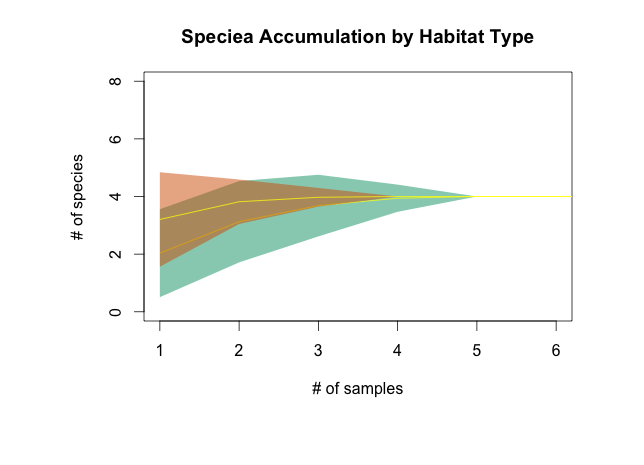Прозрачность цвета многоугольника с использованием графика и палитры дальтоников
Я использую веганский для построения кривых накопления видов.
* Я хочу наложить их на один и тот же график * Я хочу использовать дружественные цвета для слепых цветов * Я хочу использовать прозрачность с построенными полигонами
Я могу сделать первые два из вышеперечисленного (см. Пример кода ниже), но когда я использую дружественные по цвету слепые цвета RGB (чтобы разрешить использование альфы, параметр, задающий прозрачность) вместо шестнадцатеричных цветов (которые не позволяют прозрачность), я получаю сообщение об ошибке (пример: "Ошибка в rgb(0, 158, 115, 0.5): интенсивность цвета 115, а не в [0,1]")
Я знаю, что мой код не такой элегантный, как начинающий!
Как я могу сделать это с перекрывающимися полигонами в дальтониках с контролем прозрачности?
habitat1 = data.frame(species1=c(0,0,3,4,0,5,9),
species2=c(1,0,3,0,5,0,0),
species3=c(0,1,0,2,4,0,0),
species4=c(8,0,2,0,5,1,0))
habitat2 = data.frame(species1=c(3,23,13,99,1,0,0),
species2=c(1,0,3,4,0,26,0),
species3=c(7,1,8,38,4,47,7),
species4=c(7,7,2,3,5,0,8))
require(ggplot2)
require(vegan)
speca_hab1 <- specaccum(comm=habitat1, method="random", permutations=1000)
speca_hab2 <- specaccum(comm=habitat2, method="random", permutations=1000)
par(mfrow=c(1,1), mai=c(2, 2, 1, 1))
plot.new() # telling R we are starting a new plot
plot(speca_hab1, main="Speciea Accumulation by Habitat Type",
xlab ="# of samples", ylab ="# of species", ci.type="polygon",
ci.col="#CC79A7", ci.lty=0, col = "yellow", xlim = c(1, 6),
ylim = c(0, 8)) # habitat 1 - Savanna
plot(speca_hab2, xlab ="# of samples", ylab ="# of species",
ci.type="polygon", ci.col="#D55E00", ci.lty=0, col="yellow",
add=TRUE) # habitat 2 - Prairie
# colorblind friendly colors
# 0,0,0 #000000 # Black
# 230,159,0 #E69F00 # Orange
# 86,180,233 #56B4E9 # Sky Blue
# 0,158,115 #009E73 # bluish Green
# 240,228,66 #F0E442 # Yellow
# 0,114,178 #0072B2 # Blue
# 213,94,0 #D55E00 # Vermillion
# 204,121,167 #CC79A7 # reddish Purple
#-------------------------------------------------
#The following does not work:
plot.new() # telling R we are starting a new plot
plot(speca_hab1, main="Speciea Accumulation by Habitat Type",
xlab ="# of samples", ylab ="# of species", ci.type="polygon",
ci.col=rgb(0,158,115,0.5), ci.lty=0, col = "yellow", xlim = c(1, 6),
ylim = c(0, 8)) # habitat 1 - Savanna
plot(speca_hab2, xlab ="# of samples", ylab ="# of species",
ci.type="polygon", ci.col=rgb(213,94,0,0.5), ci.lty=0, col="yellow",
add=TRUE) # habitat 2 - Prairie
# color=rgb(0,0,0,alpha=0.3) gives black with a tranparency of 30%
# or, rgb(0,158,115,0.5) is 50% transparency for bluish Green
1 ответ
Ваш код не работал, потому что rgb требует пропорций. Просто разделите все значения на 255.
plot.new() # telling R we are starting a new plot
plot(speca_hab1,
main = "Speciea Accumulation by Habitat Type",
xlab = "# of samples",
ylab = "# of species",
ci.type = "polygon",
ci.col = rgb(0, 158/255, 115/255, 0.5),
ci.lty = 0,
col = "yellow",
xlim = c(1, 6),
ylim = c(0, 8)) # habitat 1 - Savanna
plot(speca_hab2,
xlab = "# of samples",
ylab ="# of species",
ci.type = "polygon",
ci.col = rgb(213/255, 94/255, 0, 0.5),
ci.lty = 0,
col = "yellow",
add = TRUE) # habitat 2 - Prairie

Вот удобная обертка, которая сделает всю работу за вас!
col2alpha <- function(col, alpha) {
col_rgb <- col2rgb(col)/255
rgb(col_rgb[1], col_rgb[2], col_rgb[3], alpha = alpha)
}
plot(speca_hab1,
main = "Speciea Accumulation by Habitat Type",
xlab = "# of samples",
ylab = "# of species",
ci.type = "polygon",
ci.col = col2alpha("#0072B2", 0.5),
ci.lty = 0,
col = "yellow",
xlim = c(1, 6),
ylim = c(0, 8))